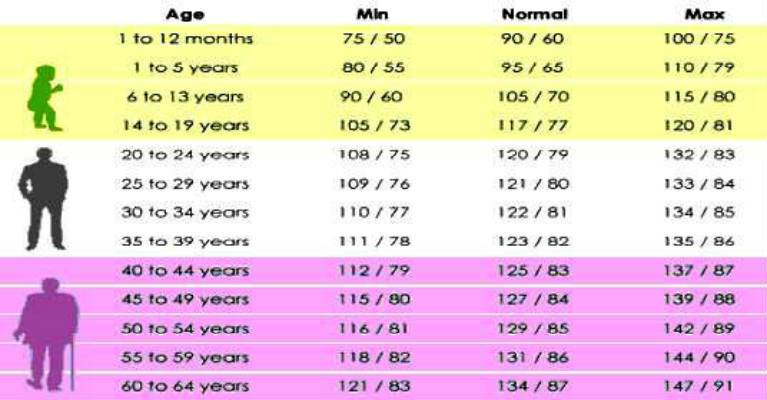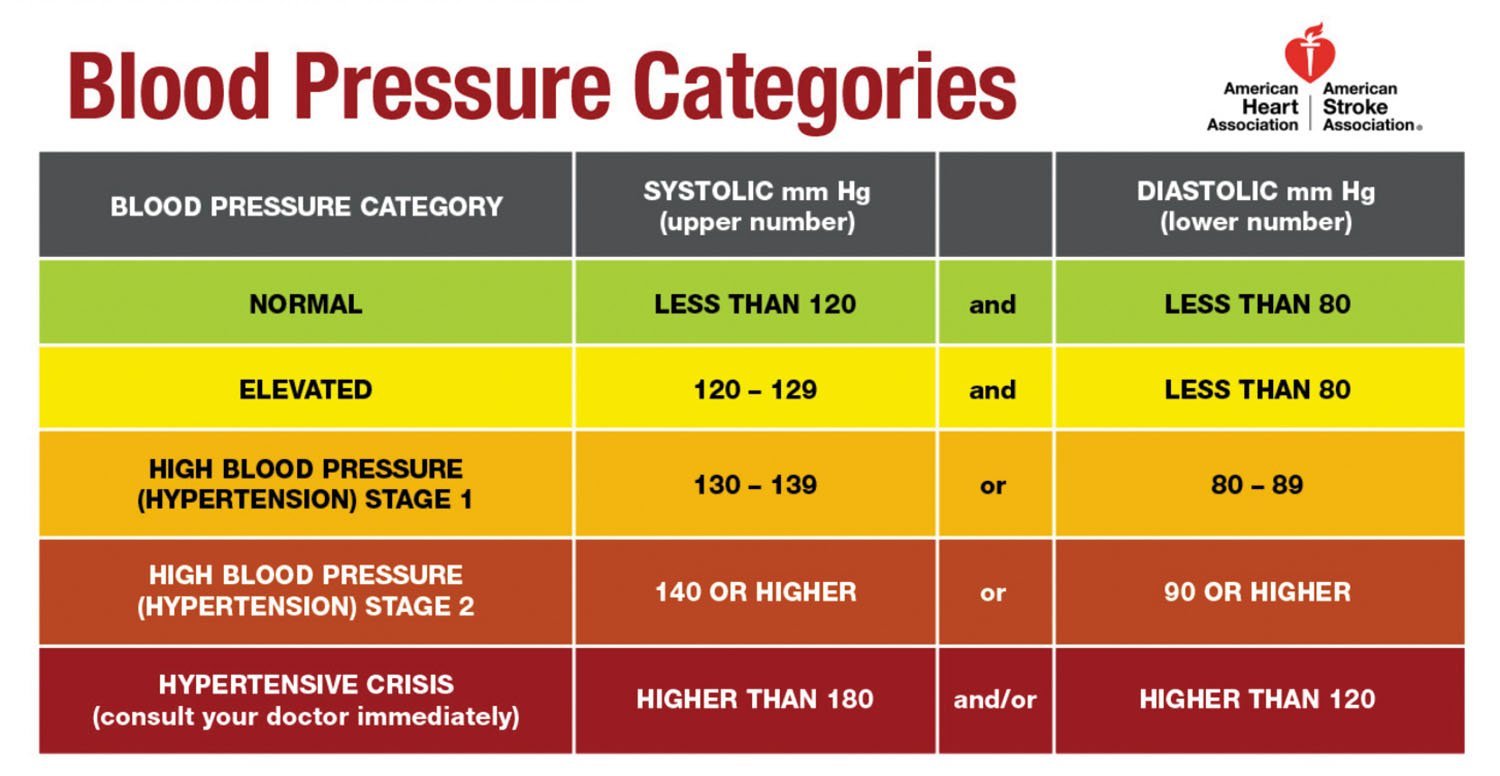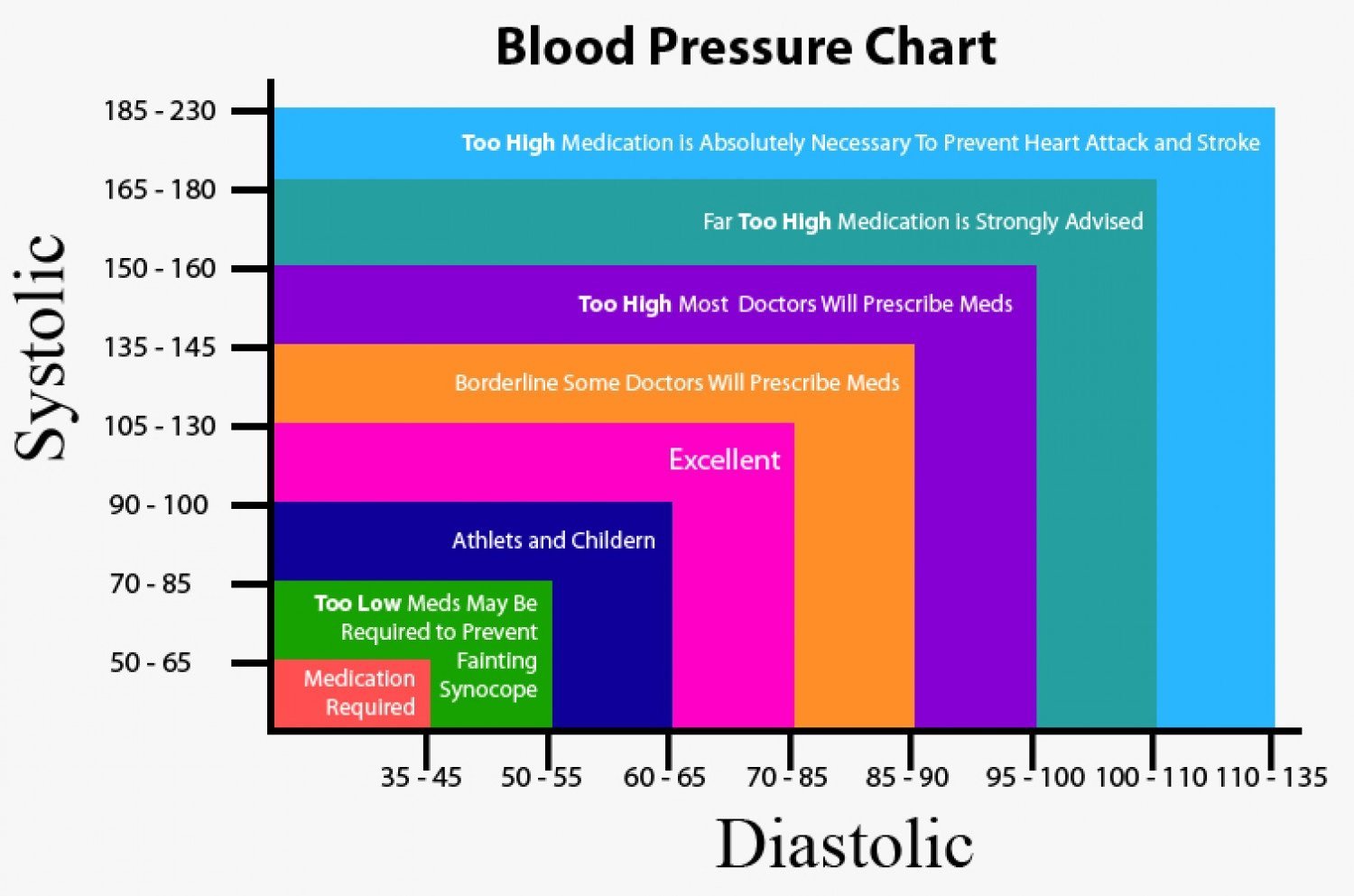How Is High Blood Pressure Treated
Doctors have a wide range of high blood pressure medicines available to treat high blood pressure. These high blood pressure treatments include diuretics — often called “water pills” — beta-blockers, calcium channel blockers, angiotensin converting enzyme inhibitors, angiotensin II receptor blockers , and other types of medication.
As effective as these drugs can be at controlling blood pressure, if you get to the point of needing them, you may have to take them for the rest of your life. That is one more good reason to focus on prevention.
Average Blood Pressure By Age
As you get older, your blood vessels tend to become stiffer and plaque can build up in them, which can raise your blood pressure. If your blood pressure becomes too high, you’re at a greater risk for heart disease, strokes, and more.
In 2015, the average blood pressure worldwide was 127/79 mm Hg in men, and 122/77 mm Hg in women, according to a study analysis published in Lancet.
When researchers for the National Center for Health Statistics looked at average blood pressure in U.S. adults between 2001 and 2008, the average reading was 122/71 mm Hg. The breakout was 124/72 mm Hg for men, and 121/70 mm Hg in women. It rose by age and was significantly higher in Black people.
The researchers found the following breakdown by age, sex, and race or ethnicity:
| Blood Pressure by Age |
|---|
As the population ages and life expectancy increases, high blood pressure is becoming more common.
Medications For High Blood Pressure
There is a large variety of medicines available to lower and manage high blood pressure. Your doctor may call them antihypertensives, .
These medications do not cure high blood pressure, but they do help manage it. Once you start to take medicines to manage your blood pressure, you may need to take them for the rest of your life. However, the dose of these medicines may change over time.
If you need to take medication, your doctor will advise you on the correct type and dose. Two or more different medications are often needed to manage blood pressure.
Make sure you take your medicines regularly. Some things that may help you remember to take them include:
- Building them into your daily routine by taking them at the same time each day.
- Keeping them somewhere that will remind you such as next to your alarm, or with your coffee or tea.
- Using a weekly pill box.
- Asking a family member or friend to remind you.
- Always carrying a list of your medicines and their doses with you.
- Entering a daily alarm in your mobile phone or download an app to remind you.
Take any blood pressure medicine exactly as prescribed. Dont stop or change your medicine, unless your doctor advises you to.
Also Check: Can Low Blood Pressure Cause Heart Attack
What Is Normal Blood Pressure For Kids
If a child has high blood pressure and is younger than 6-years old, the cause is usually related to a medical condition. This could be a heart defect, kidney disease, genetic condition, or hormonal disorders. If a child is over the age of 6 and develops high blood pressure, the cause is likely due to excess weight, poor nutrition, and lack of exercise.
According to this blood pressure chart, here is what is considered normal blood pressure for kids:
- New born: systolic , diastolic
- Infant: systolic, diastolic
- Toddler: systolic, diastolic
- Preschooler: systolic, diastolic
- School-Aged: systolicChild , diastolic
High Blood Pressure Categories

You can divide high blood pressure into five categories, according to guidelines from the American College of Cardiology:
- Normal: Normal blood pressure in adults is any blood pressure below 120/80.
- Elevated: In adults, elevated blood pressure is a systolic reading of 120-129 and a diastolic reading below 80.
- Hypertension stage I: This stage includes blood pressures ranges of 130-139 or 80-89 .
- Hypertension stage II: This stage includes blood pressures ranges above 140 or above 90 .
- Hypertensive crisis: Severely elevated blood pressure is defined as greater than 180 and/or 120 and associated with new or worsening organ damage.
Recommended Reading: Mayo Clinic High Blood Pressure Diet
Does High Blood Pressure Have Any Symptoms
High blood pressure typically doesnt have any warning signs. Thats why its often called the silent killer. Because there may not be any symptoms, many people are unaware that they have high blood pressure.
However, early detection of hypertension is key as it can increase your risk for heart disease, stroke, kidney damage, and more.
If your blood pressure is dangerously high, you may have the following symptoms:
But, its important to know about your high blood pressure and the health risks it poses before it gets to this stage.
The only way to know for sure if you have hypertension is to get your blood pressure measured. You can then work with your doctor to find the treatment options that work best for keeping your blood pressure in a healthy range.
Variations In Blood Pressure
Your blood pressure changes to meet your bodys needs. If a reading is high, your doctor may measure your blood pressure again on several separate occasions to confirm the level.
Your doctor may also recommend that you measure your blood pressure at home or have a 24-hour recording with a monitoring device.
You May Like: Can Apple Watch Test Blood Pressure
What Do The Readings Mean
As a general guide:
140/90mmHg or over you may have high blood pressureMost doctors use 140/90mmHg as the cut off for point for diagnosing . This is the point where your risk of serious health problems goes up. They might prescribe and advise you to make changes to your to bring your blood pressure down. 120/80mmHg up to 140/90mmHg pre-high blood pressureAlso called high-normal blood pressure. This is not high blood pressure, but it is a little higher than it should be and means you could go on to develop high blood pressure. See how you can make to lower it. 90/60mmHg up to 120/80mmHg ideal blood pressureAlso called normal blood pressure. Your blood pressure reading is healthy. At this level you have a much lower risk of heart disease and stroke. Following a will help you to keep it in the healthy range. 90/60mmHg or lower you may have low blood pressure usually isnt a problem, but it can sometimes make you feel faint or dizzy or could be a sign of another health problem.
The video below explains how your blood pressure numbers are linked to the risk of stroke and other disease.
High Blood Pressure And Daily Activity
Check with your doctor before starting a new activity or increasing your level or intensity. Be active safely. Build up your levels of activity gradually.
Try to do at least 30 to 45 minutes of moderate-intensity physical activity on most, if not all, days of the week. This can be done in bouts of 10 minutes or longer, if that is more convenient.
Physical activity is any form of bodily movement performed by our large muscle groups. Moderate-intensity physical activity , such as brisk walking or cycling, is enough to provide health benefits.
Walking is a great activity for all ages. You may like to join one of the Heart Foundations community walking groups.
Some types of exercises, such as body presses and lifting heavy weights, can raise your blood pressure. Avoid these if you have high blood pressure.
Recommended Reading: Treating High Blood Pressure
Get Regular Blood Pressure Checks
If your blood pressure is in the healthy range and you have no other risk factors for cardiovascular disease, and no personal or family history of high blood pressure, it is still important to have a check at least every two years. Your doctor can also check your blood pressure during routine visits.
If your blood pressure is highnormal , or if you have other risk factors for cardiovascular disease, such as a personal or family history of high blood pressure, stroke or heart attack, it is best to have it checked more frequently such as every 6 to 12 months or as directed by your doctor. Ask your doctor for advice.
Hypertension Or High Blood Pressure
- What is the definition of HTN?
- High blood pressure is defined as average systolic BP and/or diastolic BP > /= 95th percentile for age, gender and height on more than 3 occasions.
- Pre-hypertension is defined as SBP and/or DBP between 90th and 95th percentile.
- For adolescents, BP readings > /= 120/80 are considered to be pre-hypertensive.
You May Like: Claritin Blood Pressure
Signs And Symptoms Of High Blood Pressure
High blood pressure may not have any symptoms and so hypertension has been labeled “the silent killer.” Longstanding high blood pressure can lead to multiple complications including heart attack, kidney disease, or stroke.
Some people experience symptoms with their high blood pressure. These symptoms include:
- Headache
- The Feeling of pulsations in the neck or head
- Nausea
Blood Pressure Calculator: Understanding Your Blood Pressure Numbers

Please remember that for an official blood pressure diagnosis and treatment regimen, you must consult your primary physician or medical care professional who will do a thorough assessment to determine the proper diagnosis.
Enter both Systolic & Diastolic readings below. Results will display the corresponding blood pressure category & information regarding the causes, symptoms, and treatment options for your range of blood pressure.
Recommended Reading: Can Apple Watch Tell Your Blood Pressure
How Often Should You Get Your Blood Pressure Checked
If your blood pressure is higher than it should be, follow your doctors advice with regard to how often you should check your blood pressure at home. Also find out from your doctor what you should do if your blood pressure readings are higher than usual.
If you dont have high blood pressure, its still important to get it checked regularly, as blood pressure can change over time. Medical experts suggest the following timeline for low risk individuals:
- For people between 18 and 40. Get your blood pressure checked at least once every 2 years.
- For anyone over 40. Get your blood pressure checked at least once a year.
You may need to have your blood pressure checked more regularly if you:
- have a family history of hypertension
- have heart disease, diabetes, or kidney disease
- are overweight or have obesity
- have sleep apnea or insomnia
- smoke
You dont necessarily have to get your blood pressure checked at your doctors office. Some health care clinics do free blood pressure screenings. You may also schedule an appointment at your local pharmacy.
Untreated and uncontrolled high blood pressure can damage your blood vessels and other organs, including your heart, kidneys, eyes, and brain.
Complications of hypertension can include:
Cuff Placement And Size
When taking your blood pressure, its imperative that the cuff is put on correctly before starting the measurment. Be sure to refer to your devices manual for specifications and instructions on proper placement. Also, ensure that the cuff is appropriately sized for your arm. Universal cuff sizes work for most, but custom small or large cuffs are available.
Recommended Reading: Can Claritin Raise Your Blood Pressure
How Do I Know If I Have High Blood Pressure
Theres only one way to know if you have high blood pressure: Have a doctor or other health professional measure it. Measuring your blood pressure is quick and painless.
Talk with your health care team about regularly measuring your blood pressure at home, also called self-measured blood pressure monitoring.
High blood pressure is called the silent killer because it usually has no warning signs or symptoms, and many people do not know they have it.
Salt Intake And High Blood Pressure
Reducing the amount of salt you eat can also help to manage or even avoid high blood pressure. To help reduce your salt intake:
- Ensure your diet consists of wholefoods including vegetables, fruits, wholegrains, lean meat and poultry, fish and seafood, legumes, unsalted nuts and seeds.
- Avoid packaged and processed foods that are high in salt. You cant see the salt in these foods, so you dont know how much salt you are having. Get into the habit of checking food labels.
- Choose low-salt food where possible. If you cant find low-salt products, those with moderate amounts of salt are ok too. Another simple alternative is to look for labels with low salt, salt reduced or no added salt.
- Avoid adding salt to cooking or at the table flavour meals with herbs and spices instead.
You May Like: Vinegar And High Blood Pressure
Your Blood Pressure Numbers And What They Mean
Your blood pressure is recorded as two numbers:
- Systolic blood pressure indicates how much pressure your blood is exerting against your artery walls when the heart beats.
- Diastolic blood pressure indicates how much pressure your blood is exerting against your artery walls while the heart is resting between beats.
What Does It Mean When Your Blood Pressure Is Normal But Your Heart Rate Is High
Heart rates that are consistently above 100, even when the person is sitting quietly, can sometimes be caused by an abnormal heart rhythm. A high heart rate can also mean the heart muscle is weakened by a virus or some other problem that forces it to beat more often to pump enough blood to the rest of the body.
Read Also: Can I Take Claritin With High Blood Pressure
When To Check Blood Pressure
- If your blood pressure is normal , get it checked every year, or more often as your doctor suggests.
- If your blood pressure is elevated — a systolic blood pressure between 120 and 129 or diastolic blood pressure of less than 80 — your doctor will probably want to check it every 3-6 months. They will probably recommend lifestyle changes like more exercise and a better diet.
- If you have stage 1 hypertension — 130-139 over 89-90 — the doctor might suggest lifestyle changes and see you again in 3-6 months. Or they could tell you to make the changes and give you medication, then recheck your condition in a month. It depends on what other health conditions or risk factors you have.
- If you have stage 2 hypertension — 140/90 or higher — youâll likely get medication. You’ll also need to make lifestyle changes and see the doctor again in a month.
Choosing A Blood Pressure Monitor

If you’re planning to take your blood pressure at home, it’s important to have a reliable blood pressure monitor. The AHA recommends an automatic, cuff-style, bicep monitor, but there are other options.
When selecting a blood pressure monitor, consider the following:
- Fit: To ensure a proper fit, measure around your upper arm and choose a monitor that comes with the correct size cuff.
- Number of people: If more than one person will be using the monitor, make sure to choose one that fits everyone.
- Features: Some blood pressure monitors offer extra tech features, like Bluetooth and app connectivity. If you don’t think you’ll benefit from these extras, go ahead and choose one that is efficient, easy to use, and more affordable.
- Budget: High-quality blood pressure monitors vary dramatically in price, from around $25 to well over $100. Keep in mind that a good monitor is a great investment and that you will be using it daily for several years.
- Other considerations: The AHA notes that when selecting a blood pressure monitor for a senior, pregnant person, or child, you should make sure it is validated for these conditions.
If you need help selecting an at-home device, check out these blood pressure monitors, which were vetted by the Verywell team based on the above criteria.
You May Like: High Blood Pressure Shaking
Understanding Blood Pressure What Is It
Your blood pressure reading is a measurement of the pressure your blood applies across your artery walls. Your blood pressure changes a little throughout the day when you relax, your blood pressure lowers, and when you move around or feel stress, your blood pressure increases. But high blood pressure over a long term is associated with serious health risks, including heart, brain, and eye damage. Likewise, chronic low blood pressure sometimes comes with health risks. Fortunately, there are helpful ways to manage both high and low blood pressure.
Blood Pressure Reading Chart
Below is a blood pressure reading chart for you.
*Remember that the larger figure in your reading represents the systolic value the smaller figure represents your diastolic value. Systolic is the measurement of pressure when the heart is beating. Diastolic is the measurement of pressure when the heart is resting.
You May Like: High Blood Pressure Symptoms Mayo Clinic
A Summary Of Pediatric Bp Categories Stages And Follow
- The table was recreated from the articles listed below. Given that there were slight variations in BP values, we elected to include both percentiles and BP ranges.
|
Elevated or persistent or pre-HTN |
90th to 95th percentile or 120/80 mm Hg to < 95th percentile |
Consider school or home BP monitoring |
|---|---|---|
|
Stage 1 HTN |
> 95th to 99th percentile + 5 mmHg or 130-139/89 mm Hg |
Evaluate in 1 week to 1 month |
|
Stage 2 HTN |
> 99th percentile + 5 mm Hg or > /=140/90 mm Hg |
Evaluate in 1 week or sooner if symptomatic |
|
White-coat HTN |
> 95th percentile in a medical setting. Normal outside the medical setting |
Consider ABPM as well as home or school BP monitoring |
|
Masked HTN |
< 95th percentile in a medical setting. > 95th percentile outside a medical setting |
Consider ABPM in high-risk patients. |